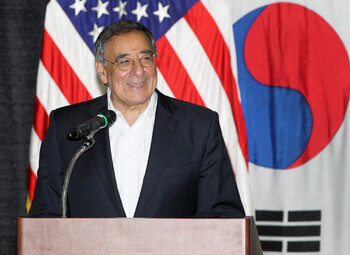hankyoreh
Links to other country sites 다른 나라 사이트 링크
First ever US Defense Minister mention of MD negotiations with Korea

By Park Hyun, Washington correspondent
On the possibility of South Korea joining a US-led missile defense system, U.S. Defense Secretary Leon Panetta said on Oct. 24, “With regard to future missile defense, that’s an area that we continue to discuss in order to make sure that we have all of the defenses necessary to deal with the missile threat coming from North Korea, and whatever steps are necessary to try to make sure that we’re prepared for that.”
Remarks were once made by a U.S. official that South Korea and Australia were discussing a ballistic missile defense system along with the U.S., but this marks the first time that a U.S. defense minister has cited ongoing discussions on South Korea’s participation in U.S. missile defense system.
At a joint press conference held immediately following the 44th ROK-US Security Consultative Meeting (SCM) held at the Pentagon in Washington, Secretary Panetta made the above statements in response to the question, “After the announcement of revised missile guideline, opposition lawmakers in South Korea raised speculations that Washington wants Seoul to join its missile defense system. So can you tell us the U.S. government’s position to clarify about the issue?” The press conference started 30 minutes behind schedule as talks between Secretary Panetta and his South Korean counterpart Kim Kwan-jin were drawn out.
Panetta mentioned a specific case of joining in missile defense by saying “We just deployed - or we just talked about deploying a TPY-2 radar system to Japan specifically in order to protect against that kind of missile threat,” adding, “We will continue to work with our friends in the region to further develop that kind of capability.” Last month, the U.S. and Japan agreed to deploy a second X-band missile defense radar in Japan.
Some have raised suspicions that the South Korean government might have agreed to join the U.S. missile defense shield in a backdoor agreement in return for the U.S.’s revisions of missile guidelines that expanded the permissible range of Korean missiles to 800 km. Some also predicted that such an agreement would take shape at this SCM. Secretary Panetta’s remarks in the press conference are seen as reflecting his determination to make public South Korea’s joining of the U.S.’s missile defense system.
Even though he was not asked for his opinion on the revisions to the missile guidelines, Panetta mentioned, “South Korea and the United States have worked through the issue of missile guidelines. We have various conditions that both of us have agreed to as to how that would operate,” in response to a query on the missile defense system. Concerning how South Korea could join the U.S. missile defense system, issues to be discussed are the integration of South Korea military’s weapon systems, the idea of including Korea’s Patriot missiles and Aegis ships in the U.S. missile defense system, and the deployment of a U.S. radar base in South Korea.
On the issue, the South Korean government maintains it plans to develop a “Korea Air and Missile Defense”(KAMD) system tailored for South Korea, focused on low-tier defense to respond to the threat of North Korean missiles, and the KAMD is completely unrelated to the U.S.’s missile defense system.
A military source said on Oct. 25, “The Korean missile defense system is specifically designed to intercept North Korean missiles at a low altitude,” adding, “It cannot be seen as related to the U.S. missile defense system that is tailored for altitudes higher than that.”
Please direct questions or comments to [english@hani.co.kr]

Editorial・opinion
![[Column] Has Korea, too, crossed the Rubicon on China? [Column] Has Korea, too, crossed the Rubicon on China?](https://flexible.img.hani.co.kr/flexible/normal/500/300/imgdb/original/2024/0419/9317135153409185.jpg) [Column] Has Korea, too, crossed the Rubicon on China?
[Column] Has Korea, too, crossed the Rubicon on China?![[Correspondent’s column] In Japan’s alliance with US, echoes of its past alliances with UK [Correspondent’s column] In Japan’s alliance with US, echoes of its past alliances with UK](https://flexible.img.hani.co.kr/flexible/normal/500/300/imgdb/original/2024/0419/2317135166563519.jpg) [Correspondent’s column] In Japan’s alliance with US, echoes of its past alliances with UK
[Correspondent’s column] In Japan’s alliance with US, echoes of its past alliances with UK- [Editorial] Does Yoon think the Korean public is wrong?
- [Editorial] As it bolsters its alliance with US, Japan must be accountable for past
- [Guest essay] Amending the Constitution is Yoon’s key to leaving office in public’s good graces
- [Editorial] 10 years on, lessons of Sewol tragedy must never be forgotten
- [Column] A death blow to Korea’s prosecutor politics
- [Correspondent’s column] The US and the end of Japanese pacifism
- [Guest essay] How Korea turned its trainee doctors into monsters
- [Guest essay] As someone who helped forge Seoul-Moscow ties, their status today troubles me
Most viewed articles
- 1[Column] The clock is ticking for Korea’s first lady
- 2Hong Se-hwa, voice for tolerance whose memoir of exile touched a chord, dies at 76
- 3After 2 months of delayed, denied medical care, Koreans worry worst may be yet to come
- 4[Column] Has Korea, too, crossed the Rubicon on China?
- 5[Correspondent’s column] In Japan’s alliance with US, echoes of its past alliances with UK
- 6US overtakes China as Korea’s top export market, prompting trade sanction jitters
- 7Samsung barricades office as unionized workers strike for better conditions
- 8All eyes on Xiaomi after it pulls off EV that Apple couldn’t
- 9More South Koreans, particularly the young, are leaving their religions
- 10John Linton, descendant of US missionaries and naturalized Korean citizen, to lead PPP’s reform effo